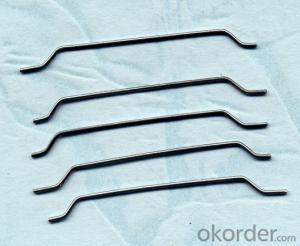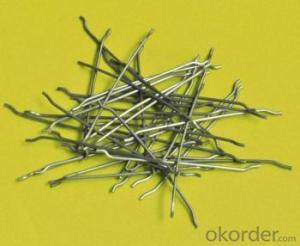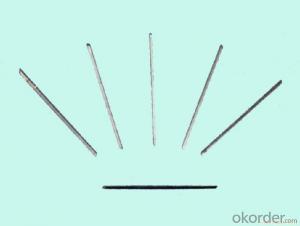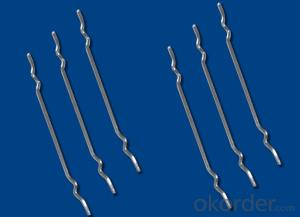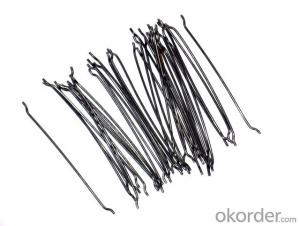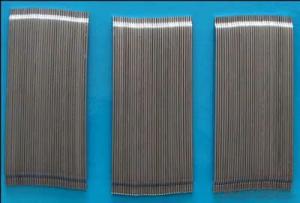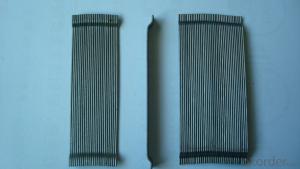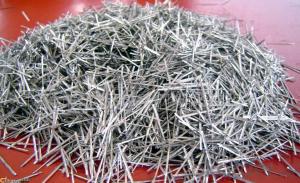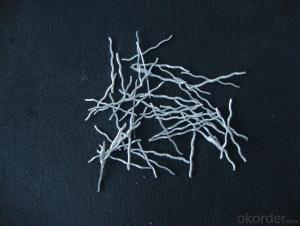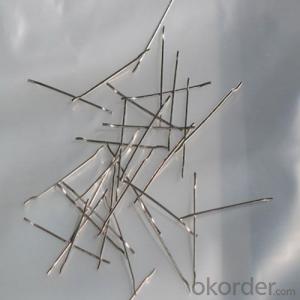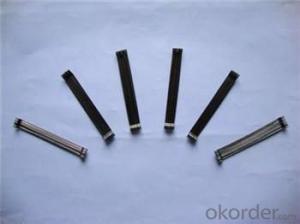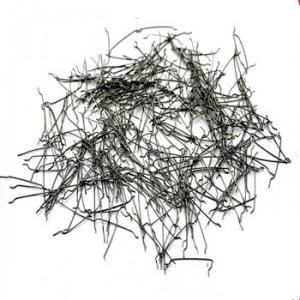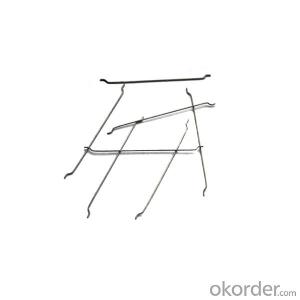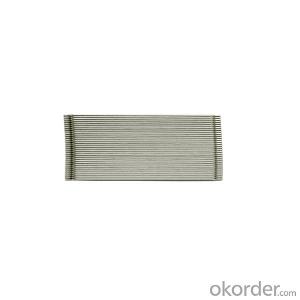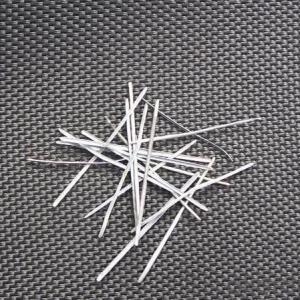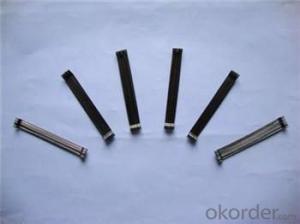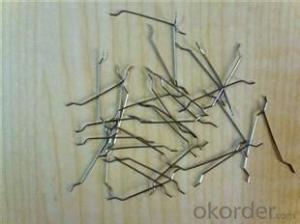Melt Extract Stainless Steel Fiber - Straight Type Copper Coated for Concrete
- Loading Port:
- Tianjin
- Payment Terms:
- TT OR LC
- Min Order Qty:
- 1000 kg
- Supply Capability:
- 30000 kg/month
OKorder Service Pledge
OKorder Financial Service
You Might Also Like
Quick Details
Place of Origin: China (Mainland)
Model Number: HT-ST
Material: Steel
The Products
Steel fiber for Concrete Reinforcement
High tensile strength 2.Length 6-60mm 3.Diameter 0.2-1.0mm
Specifications
Steel fiber for Concrete Reinforcement
1.High tensile strength
2.Length 6-60mm
3.Diameter 0.2-1.0mm
4.ISO9001, CE, TUV
Specification | Diameter (mm) | Length (mm) | Aspect ratio (L/D) | Tensile strength (Mpa) |
0.12/6 | 0.12 | 6 | 50 | 2500 |
0.2/6 | 0.2 | 6 | 30 | 2500 |
0.2/13 | 0.2 | 13 | 65 | 2500 |
0.3/25 | 0.3 | 25 | 83 | 2500 |
0.4/25 | 0.4 | 25 | 63 | 1200 |
0.4/30 | 0.4 | 30 | 75 | 1200 |
0.5/30 | 0.5 | 30 | 60 | 1100 |
0.5/25 | 0.5 | 25 | 50 | 1100 |
0.55/25 | 0.55 | 25 | 45 | 800 or 1000 |
0.6/30 | 0.6 | 30 | 50 | 1000 or 1100 |
0.7/30 | 0.7 | 30 | 43 | 1000 |
0.7/35 | 0.7 | 35 | 50 | 1000 |
0.75/35 | 0.75 | 35 | 47 | 1000 |
0.75/60 | 0.75 | 60 | 80 | 1000 |
0.8/60 | 0.8 | 60 | 75 | 1000 |
0.9/50 | 0.9 | 50 | 56 | 1000 |
0.9/60 | 0.9 | 60 | 67 | 1000 |
1.0/50 | 1.0 | 50 | 50 | 1000 |
1.0/60 | 1.0 | 60 | 60 | 1000 |
Picture
Steel fiber straight type
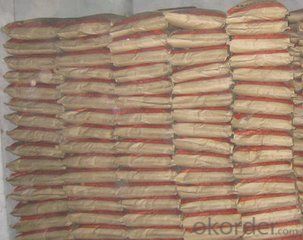
pp bag
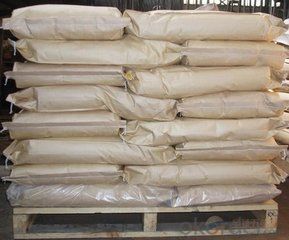
any type steel fiber
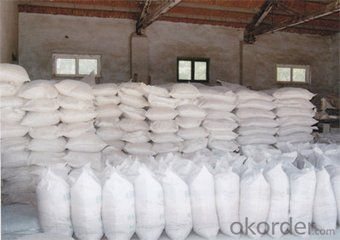
FAQ
certificated: ISO 9001
Technical advantages of Daye steel fiber:
A. Improve mechanical performance of concrete
B. Provide uniform distribution throughout concrete with excellent mixing
C. No balling or caking by adopt correct mixing method
D. Reduce concrete volume
- Q: How does the addition of melt extract stainless steel fiber affect the impact strength of concrete?
- The addition of melt extract stainless steel fiber to concrete can significantly improve its impact strength. Stainless steel fibers are strong and durable materials that are added to concrete mixes to enhance their mechanical properties. When mixed with concrete, these fibers create a three-dimensional network that improves the overall toughness of the material. This network acts as a reinforcement system, which absorbs and redistributes the energy generated during an impact event, thereby reducing the risk of cracking and fracture. The use of stainless steel fibers in concrete enhances its resistance to impact loads by increasing its flexural strength and ductility. This means that the concrete is better able to withstand sudden or repeated impacts without losing its structural integrity. Furthermore, the addition of stainless steel fibers also improves the overall durability of the concrete. Stainless steel is highly resistant to corrosion and oxidation, making it an ideal material for reinforcing concrete structures. By incorporating stainless steel fibers, the concrete becomes more resistant to environmental factors, such as moisture and chemical attacks, which can weaken the material over time. In conclusion, the addition of melt extract stainless steel fiber to concrete significantly enhances its impact strength by improving its toughness, resistance to cracking, and overall durability. This makes it a valuable addition for applications where concrete is subjected to high impact loads, such as industrial floors, pavements, and structures in seismic zones.
- Q: Can melt extract stainless steel fiber be used in the construction of stadium seating areas?
- Yes, melt extract stainless steel fiber can be used in the construction of stadium seating areas. Its high tensile strength, durability, and resistance to corrosion make it an ideal material for reinforcing concrete structures, ensuring the safety and longevity of stadium seating areas.
- Q: What is the effect of melt extract stainless steel fiber on the modulus of rigidity of concrete?
- Concrete's modulus of rigidity is generally improved by the addition of melt extract stainless steel fibers. These fibers reinforce the concrete matrix, enhancing its overall performance and mechanical properties. The modulus of rigidity, or shear modulus, measures a material's stiffness and ability to resist deformation under shear stress. By incorporating stainless steel fibers, the modulus of rigidity is increased, resulting in a more rigid and durable concrete structure. Stainless steel fibers act as reinforcement within the concrete, providing additional strength and improving its tensile strength and crack resistance. This reinforcement prevents cracks from propagating and enhances the concrete's ability to withstand external loads and stresses. Furthermore, the inclusion of melt extract stainless steel fibers enhances the flexural strength of the concrete, enabling it to withstand bending forces without failure. This contributes to the overall rigidity of the concrete structure. The stainless steel fibers also help to evenly distribute applied loads throughout the concrete, reducing localized stress concentrations. This leads to a more uniform distribution of forces, ultimately enhancing the modulus of rigidity. In conclusion, the addition of melt extract stainless steel fibers has a positive impact on the modulus of rigidity of concrete, resulting in a stronger and more durable material. These improved mechanical properties make it suitable for various applications requiring high-performance concrete, such as infrastructure projects, industrial flooring, and seismic-resistant structures.
- Q: What is the effect of melt extract stainless steel fiber on the modulus of elasticity of concrete?
- By incorporating melt extract stainless steel fibers into concrete, the modulus of elasticity can be positively influenced. The modulus of elasticity refers to the capacity of a material to deform elastically under stress and subsequently return to its original shape upon stress removal. The stainless steel fibers serve as reinforcement within the concrete matrix, thereby enhancing its mechanical properties. These fibers augment the tensile strength of the concrete, impeding the propagation of cracks and increasing its ability to withstand bending or flexural stresses. Consequently, the modulus of elasticity of the concrete is enhanced. The inclusion of melt extract stainless steel fibers aids in the uniform distribution of stress throughout the concrete, diminishing stress concentration at specific points and improving the overall structural integrity. This enables the concrete to bear heavier loads and enhances its durability. Moreover, the presence of stainless steel fibers further strengthens the bond between the concrete matrix and the fibers themselves. This fortified bond facilitates the transmission of stress from the matrix to the fibers, thereby amplifying the overall strength and rigidity of the concrete. In summary, the incorporation of melt extract stainless steel fibers into concrete has a positive influence on the modulus of elasticity by enhancing the material's tensile strength, crack resistance, and overall durability.
- Q: Can melt extract stainless steel fiber be used in airport pavement applications?
- Yes, melt extract stainless steel fiber can be used in airport pavement applications. It provides enhanced strength and durability to concrete, making it suitable for heavy traffic areas like airports. The stainless steel fibers also offer resistance to corrosion and fatigue, ensuring a longer lifespan for the pavement.
- Q: Does melt extract stainless steel fiber enhance the flexural toughness of concrete beams?
- Concrete beams experience an enhancement in flexural toughness when melt extract stainless steel fiber is utilized. The inclusion of these fibers in concrete mixtures leads to a significant improvement in the beams' ability to withstand bending and flexural forces. By incorporating stainless steel fibers, the material's tensile strength and ductility are increased, resulting in a strengthened resistance to cracking and an overall improvement in toughness. This reinforcement ensures that applied loads are evenly distributed, reducing the likelihood of brittle failure and enhancing the structural performance of the concrete beams. Furthermore, the small size and high aspect ratio of melt extract stainless steel fibers enable better dispersion and bonding within the concrete matrix, further heightening their effectiveness in enhancing flexural toughness.
- Q: Is melt extract stainless steel fiber compatible with all types of concrete additives?
- No, melt extract stainless steel fiber may not be compatible with all types of concrete additives. Compatibility depends on the specific type and properties of the additives used. It is important to consult with manufacturers and conduct compatibility tests to ensure proper performance and compatibility when using melt extract stainless steel fiber with concrete additives.
- Q: How does the addition of melt extract stainless steel fiber impact the curing time of concrete?
- The addition of melt extract stainless steel fiber to concrete can significantly impact the curing time. This type of fiber acts as a reinforcement in the concrete matrix, providing enhanced strength and durability. Due to its high thermal conductivity, the stainless steel fiber helps to dissipate heat generated during the hydration process, resulting in faster curing. This accelerated curing time can lead to earlier strength development and reduced overall construction time.
- Q: Can melt extract stainless steel fiber be used in asphalt or bitumen?
- Certainly, melt extract stainless steel fiber finds its application in asphalt or bitumen. It is a prevalent choice as a reinforcement material in the manufacturing process of asphalt or bitumen, as it amplifies its strength, durability, and resistance to cracking. During the production stage, the fibers are incorporated into the mix, ensuring an equal dispersion for reinforcement across the entirety of the asphalt or bitumen mixture. By incorporating stainless steel fibers, the overall performance and lifespan of the asphalt or bitumen are significantly improved, rendering it more resilient against fatigue and cracking induced by intense traffic or external elements.
- Q: How does melt extract stainless steel fiber impact the shrinkage cracking of concrete pavements?
- The use of melt extract stainless steel fiber can have a significant impact on reducing shrinkage cracking in concrete pavements. Shrinkage cracking occurs when the concrete undergoes volume reduction due to drying and thermal shrinkage, which can lead to the formation of cracks. By adding melt extract stainless steel fiber to the concrete mixture, it enhances the overall tensile strength and ductility of the concrete. These fibers act as reinforcement, distributing stress and preventing the formation and propagation of cracks. The fibers also help to control the plastic shrinkage by reducing the water evaporation rate from the concrete surface. The stainless steel fibers are uniformly distributed throughout the concrete matrix, creating a three-dimensional reinforcement system. This reinforcement improves the concrete's resistance to shrinkage stresses, reducing the likelihood of shrinkage cracking. Additionally, the use of melt extract stainless steel fiber can enhance the durability and lifespan of concrete pavements. The fibers improve the concrete's resistance to abrasion, impact, and fatigue, making it more resilient to the stresses and strains of traffic loads. In conclusion, melt extract stainless steel fiber has a positive impact on the shrinkage cracking of concrete pavements. It improves the concrete's tensile strength, ductility, and resistance to shrinkage stresses, reducing the occurrence of cracks. The use of these fibers also enhances the durability and lifespan of concrete pavements, making them more reliable and long-lasting.
Send your message to us
Melt Extract Stainless Steel Fiber - Straight Type Copper Coated for Concrete
- Loading Port:
- Tianjin
- Payment Terms:
- TT OR LC
- Min Order Qty:
- 1000 kg
- Supply Capability:
- 30000 kg/month
OKorder Service Pledge
OKorder Financial Service
Similar products
Hot products
Hot Searches
Related keywords
